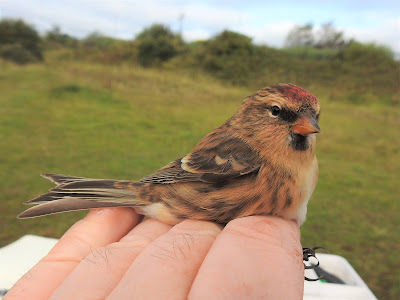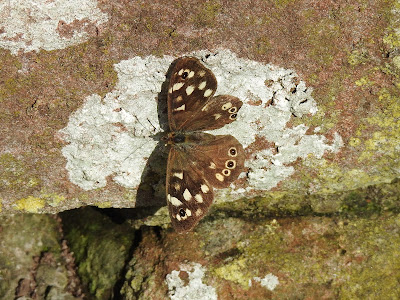This is a post about ringing, or perhaps more to the point, it is a post about the memories that cold, stark ringing data can evoke.
Sounds and smell can transport you to a place, or an event, in an instant when that sound or smell triggers a memory, and it can be a very strong memory. For instance, when I used to own one of those smelly waxed Barbour jackets, the smell of it transported me to Long Point Bird Observatory in Canada. It wasn't that I didn't wear that coat anywhere else, but at Long Point I wore it every day for several months. The sound of Black-headed Gulls calling, places me in the Public Hide at Leighton Moss RSPB reserve, as a teenager birder in the late 70s/early 80s. I only have to hear a Swallow singing, and I am in a reedbed in late evening, catching roosting Swallows as the, then, loop tape blasts out Swallow song to concentrate the birds towards our net rides.
There are many examples that I could quote, but I think that you get the picture. Every year for my own interest I produce the annual ringing totals for Fylde Ringing Group (FRG), a group that I joined as a founder member back in 1984. The group's records actually start in 1983, as that was when my ringing trainer moved to the Fylde area and started ringing birds at Clifton Hall, near Preston. Mark was then ringing under the auspices of Leigh Ringing Group, and it was in 1984 that he took on three trainees, me included, and Fylde Ringing Group was born.
The FRG totals were up to date, up until the end of 2016, so over the past couple of days I have brought them up to date up until the end of 2019. It was a bit of a mammoth task as we shifted recording systems for the ringing data with the British Trust for Ornithology (BTO) in 2017, from Integrated Population Monitoring Reporter (IPMR), to Demography Online (DemOn), and not all the historical data is on DemOn. So, to cut a long story short, with a combination of both systems, the FRG ringing totals have been brought up to date.
Ringing produces lots of scientific data on bird populations that is used for conservation purposes, besides all the biometric data that gets recorded, there is also just the pure totals of how many birds have been ringed, whether that is on a national scale, by site, by individual ringer or group. As I was updating the tables of the total numbers and species of birds ringed by FRG, it evoked lots of memories. Certain totals for some species, or certain individuals ringed decades ago, evoked lots of vivid memories, and just for no other reason other than pure indulgence, and nostalgia for me, I'll touch upon a few of those species and memories here.
In fact, I sometimes wonder whether writing a blog is a form of therapy. I think it was Steve, who writes the stonking blog
North Downs and Beyond, who was ruminating on this topic some time ago, and he said that he would write his blog even if nobody read it, as he found the whole writing process cathartic, and I have to agree.
Anyway, I digress, so back to those data memories. We, that is FRG, have ringed 118,890 birds of 116 species. Not a huge total, about 3,300 birds a year, but nevertheless fairly representative of a small band of ringers.
Back in the early 1990s we had the opportunity to ring some
Grey Heron chicks at a fledgling Heronry on an island in a local municipal park. At this stage a number of the trees that the Herons were nesting in were quite low, and it was possible to access the nests with a ladder. The only problem was getting the ladders to the island! The Council kindly offered us the loan of one of the rowing boats that members of the public can rent out for leisure purposes on parts of the lake. Now, the boat was nowhere near as large as the ladders, so how would we get the ladders, plus ringers on the boat and across to the island
?
Grey Heron
The answer was for one of us to row across to the island with a rope attached from the boat to the mainland. After disembarkation at the island, the boat could then be pulled back to the mainland. There was also a rope attached from the boat to the island, so the ladders could be tied to the boat and pulled across to the island. Once the ladders were unloaded, the empty boat could be pulled back to the mainland, and a couple of ringers could board and commute across to the island.
Now, if you haven't popped your head into a Grey Heron's nest then I would recommend that you never do, unless you want a grievous assault on your olfactory senses. In short, the nest doesn't half pong! It is littered with dead uneaten fish, amphibians, small mammals and various remains of! Plus, a good healthy coating of guano to boot, adds to the aroma. Anyway, it was a great experience and we ringed seven healthy chicks.
We have a bit of a history in our early days, of ringing birds on an island. At the marine lakes at Fleetwood, on the only lake of the three lakes with an island,
Greenfinches and
House Sparrows used to roost during the winter months in an area of Privet hedge.
Greenfinch
Back in the 1980s our ringing trainer, Mark, thought it would be a good idea to try and catch and ring them. Peter, one of my fellow trainees and long-standing birding friends, had an inflatable dinghy we could use. The only problem with the dinghy was that it had a slow puncture! So, when you made it across to the island you had to blow it up, by mouth, before making the return journey to the mainland with the birds. Similar to the Grey Heron experience, and this pre-dates the Herons, we tied a rope from the island to the boat, to the mainland, so it could be pulled back and forth.
House Sparrow
To date FRG have ringed 382 House Sparrows and 8,030 Greenfinches, and a good percentage of these totals comes from this period. We have also caught good numbers of Greenfinches in the Autumn when they are moving on 'vis', and Ian and I have had great success over the years pulling them down at the coastal farm fields within the Obs recording area. It's interesting to note, that on nearly every occasion we never recorded any Greenfinches going over, until we switched on the MP3 player, and then they would descend from the heavens towards the player. The magic of migration!
Of course, these data memories also bring back memories of friends and fellow ringers, a veritable cast of characters that have swelled the ranks of FRG over the years.
I have suddenly realised that this is already quite lengthy considering I have discussed just two species from my data memories, so it is my plan to serialise these tales. Don't worry, I'm not going to comment on all 116 species, just the ones that evoke the warmest memories. Part two will be coming sometime soon-ish.

































